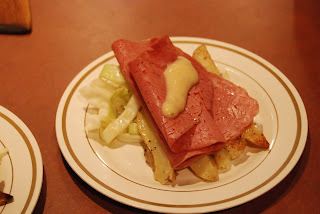Corned beef and Cabbage is thought of as the staple dish of St. Patrick's Day, and this is true outside of Ireland. Back in the old country, a thick meaty rasher of bacon was the main course to the cabbage and potatoes, not beef. When thousands of Irish immigrated to America in the 19th and early 20th centuries, they found their usual cuts of pig to be far too expensive—so they took a cue from their Jewish neighbors who were enjoying corned beef.This doesn't, however, mean that we have to abandon the concept entirely: rather, it is useful as a starting point for new versions of an Irish (-American) classic.
The concept of deconstruction and reconstruction are very popular in modern kitchen settings. An episode of Top Chef or Chopped will usually include one "Deconstructed Caesar Salad" or "Deconstructed Grilled Cheese Sandwich" or some similarly silly-sounding item. This concept, in fact, has become somewhat overused and is now being left behind in favor of "Reconstructing" items.
It is useful here to explain some terms.
Deconstructing a dish is the idea of taking a recognizable food item—a Caesar Salad, say—and breaking it down into its component gustatory and textural pieces. For the aforementioned salad, you have the romaine, the dressing, the crouton, and the Parmesan cheese. Each of these flavors, when combined, create the Caesar salad—on their own, however, they can each have unique flavor properties as well. Deconstructing the salad, then, becomes about isolating what it is from each part of the salad that makes it a whole, and re-imagining those parts into individual pieces. Once all of the parts are consumed, the flavor of a Caesar salad remains. Chef Michael Voltaggio created such a dish on Top Chef, which set my mind with a true understanding of the nature of "deconstructive" cooking. The idea of this salad is that when consumed, all of the individual components—separate on the plate—will combine into a recognizable Caesar salad.
Reconstructing a dish is similar in function to deconstruction. The individual flavors of a finished dish are isolated and worked into a new finished dish, recognizably the same as the original, but different in some significant manner—from plate arrangement to ingredients. A reconstructed Caesar salad might take the form of a sandwich on toasted Italian bread, with a nice garlicky aïoli and Parmesan spread (or maybe a Parmesan crisp,) romaine lettuce, and a fried egg. The flavors and components of a Caesar salad remain, but assembled together in a different manner.
The idea of this dish was to take the typical Corned Beef and Cabbage dinner dish, a hearty combination of cooked, warm corned beef and cabbage, and re-create it into a dish that would capture the flavors and concept, while also transforming it into an appetizer course.
A little tour of my thought process: (Sadly, I don't have any scribblings on a napkin for this.)
- Cold appetizers are easier to pull off than warm ones, as I don't have to cook anything à la minute when I'm doing them cold.
- I want to work potatoes into as many dishes as possible.
- Corned beef and mustard work well together. Potatoes and mustard work well together. Mustard can be a component of a cole-slaw dressing.
- Cabbage as a cole-slaw-style item is not typically done with a corned beef and cabbage preparation.
- Roasted Fingerling Potato and Cabbage Salad with Dijon Mustard Vinaigrette Dressing, and Cold Sliced Corned Beef.
A light but delicious dish. To the recipes!
Reconstructed Corned Beef and Cabbage
Dressing
5 tbsp (75 ml) white wine vinegar
3 tbsp (45 ml) Dijon mustard
10 tbsp (150 ml) vegetable oil
1/4 tsp. (1.25 ml) dried sage
salt and freshly ground black pepper, to taste
Salad
24 fingerling potatoes, quartered and roasted
salt and freshly ground black pepper
dried sage
olive oil
2 cups (473 ml) thinly sliced green cabbage
1 cup (237 ml) sliced green onions
3 medium-size carrots, shredded or julienned
24 slices cooked corned beef
1. Combine vinegar and dijon mustard, season with salt, pepper, and sage. In a thin, steady stream, add oil, whisking well to combine. Set aside and refrigerate.
2. Slice fingerling potatoes into quarters, lengthwise. Place in a bowl and toss with ample olive oil. Season with salt, pepper, and sage. Roast in a 425°F/220°C/Gas Mark 7 oven until lightly browned and cooked through. Cool completely and dress with the vinaigrette.
3. Combine green onion, cabbage, and carrot. Add dressing to moisten well, and toss to coat.
4. Plate up with the cabbage salad first, potatoes atop that, and a slice of corned beef with a small amount of the dressing on it.
Serves 24.



I really liked this salad, and it was good to eat potatoes with mustard, and not mayo for once!
ReplyDelete